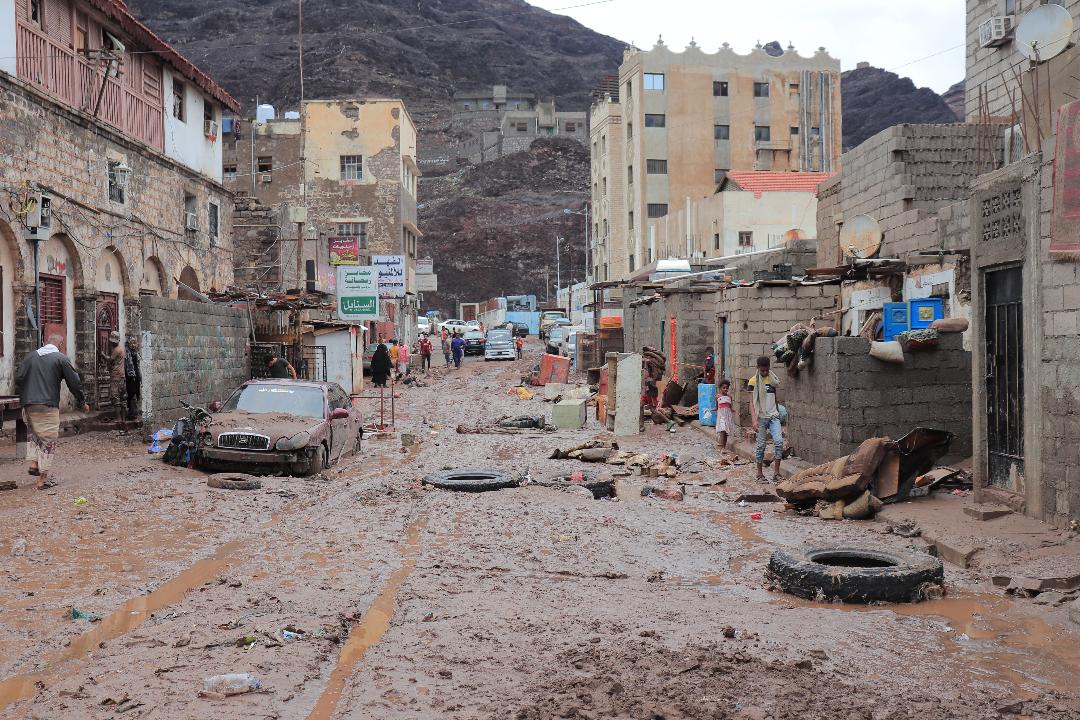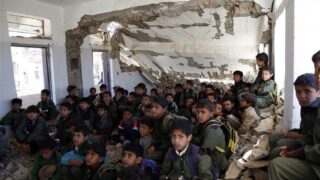
This publication has benefited from the support of the Rosa Luxemburg Foundation. This text may be reproduced in part or in full, provided the source is acknowledged.
In February 2021, news spread of a second wave of the pandemic about to hit Yemen. Once more, social media filled up with obituaries and condolences. A wave more violent than its predecessor was expected, there were less preparations, and almost no precautions.
What’s changed, then, since last year? And how could one speak of precautionary measures in such terrible and exceptional circumstances within which Yemenis live?
What prevents implementing preventive measures? What destroys every chance at containing the pandemic? Obstacles include the deteriorated economic situation, living conditions, large families, millions of displaced people, shortage of water in general and safe drinking water in specific, difficulty and high costs of transportation, and a popular culture that handles a pandemic with denial.
Could Yemenis afford precautionary costs?
The World Health Organisation (WHO) has determined a set of rules as precautionary and protective measures that would help limit the pandemic outbreak. These include the following:
- Wearing a mask at all times, cleaning and disposing of it.
- Avoiding crowded places, and staying home as much as possible.
- Continuously cleaning hands, before and after wearing a mask, and at all times.
- Disinfecting frequently touched objects and surfaces.
Such instructions seem quite simple, but to a Yemeni, those are harder to implement and even more ironic than that other advice provided in WHO guidelines: “If you have a fever, cough and difficulty breathing, seek medical attention immediately. Call by telephone first, if you can, and follow the directions of your local health authority.” (1)
On both individual and collective levels, protective measures call for a certain amount of economic and living stability in the first place. Nearly 80 percent of Yemenis (of a total of 30 million) drudge under the poverty line.
Covid-19 in Yemen: A Weaponless Battle
08-06-2021
For the fifth year in a row, nearly 600 thousand employees (under Houthi control) have yet to receive their salaries (the sixth year is about to begin this upcoming September, with no change visible on the horizon). These people provide for families of their own, which ups that number to nearly five million. In the meantime, the prices of food items and consumables are constantly on the rise, as “black” markets devastate citizens (especially in Houthi-controlled areas) which regulate the trade of oil derivatives and cooking gas. With the outbreak of the pandemic, medicine and medical supplies have joined the list of missing items. Speaking of stability, in all its shapes and forms, is thus basically out of the question.
Nearly 80 percent of Yemenis drudge under the poverty line. For the fifth year in a row, nearly 600 thousand employees (under Houthi control) have yet to receive their salaries. These people provide for families of their own, which ups that number to nearly five million. In the meantime, the prices of food items and consumables are constantly on the rise, as “black” markets devastate citizens…
Such wretchedness has not only stopped the majority of people from taking precautions, but also prevented the unfortunate from receiving proper healthcare. The medical field in Yemen is generally precarious, quite costly, whether in receiving healthcare itself or even accessing it – for those who live in remote areas with no access to hospitals. Transportation costs had doubled as a result of the oil derivatives crisis…
In 2020, during the first wave of the pandemic, the northern and southern authorities rushed to impose chaotic precautionary measures, directly affecting those individuals without the luxury of financial stability. Those are the daily wagers, small artisans, schools (with their teachers, cleaners, and janitors), food vendors, cafes, markets (fish markets, for instance, when measures were first imposed), weddings (and wedding halls, workers, and caterers), among others in this long and miserable list. While those measures may have been necessary to take, their human cost has been exorbitant; people spoke of starving to death as opposed to dying in a pandemic. On the other hand, those with stable jobs who did want to apply the recommended precautions also couldn’t protect themselves; contrary to other places in the world, working remotely or from home was unavailable to the majority of Yemenis. People were afraid of asking for leave or for the permission to work from home lest they end up substituted, or lose their jobs.
During the first wave of the pandemic, many lost their limited and only source of income. Even for those who did keep their jobs, many weren’t able to incorporate the advice that WHO provided as preventive measures: buying supplies like masks was economically taxing and far from prioritised – the same applies to sanitisers, vitamins, and so on. The black market flourished with such goods, however, as others, like Vitamin C, disappeared from the market. In 2021, throughout the second wave of the pandemic, people completely let their guard down; as authorities enforced no precautionary measures, death cases doubled. (2)
Such wretchedness not only stopped the majority of people from taking precautions, but also prevented the unfortunate from receiving proper healthcare. The medical field in Yemen is generally precarious, quite costly, whether in receiving healthcare itself or even accessing it – for those who live in remote areas with no access to hospitals. Transportation costs had doubled as a result of the oil derivatives crisis. Published data shows that the price of diesel rose from 150 riyals/litre at the end of 2014 to 438 riyals/litre in late November 2019, rising by nearly 192 per cent. Likewise, petrol prices rose from 158 riyals/litre at the end of 2014 to 379 riyals/litre in late November 2019, rising by 140 per cent. (3)
These numbers demonstrate the increases that took shape between 2014 and 2019. However, these numbers only doubled, once more, in the past two years. For example, recently this past march, the Hadi-headed Internationally Recognised Government announced a rise in fuel prices three times in less than one month, and so the price of one jerrycan of benzine (with a 20-litre capacity) rose from 5600 riyals to 10 thousand riyals. Likewise, one jerrycan of diesel (with a 20-litre capacity) rose from 6500 riyals to 10,400 riyals. (4)
Such increases are naturally followed by an increase in the prices of food items and services, mainly water provision and transportation. As such, patients don’t choose not to receive medical care or neglect precautionary measures, but are rather forced into doing so – as the only option available. They set aside whatever money they have, if they have it, that is, for the necessities that would help keep them alive.
Overcrowding as a Yemini way of life
As with most eastern societies, Yemini families are large and extensive, while the homes they inhabit are small and unequipped to hold such numbers. Furthermore, one important and critical factor may be added: the semi-constant power outages, with devastating implications in hot regions. As such, options like staying at home, working from home, or self-quarantining are rendered illogical and rather impossible to the vast majority of large and overcrowded families.
The same applies to markets, means of transportation, roads, restaurants, and so on. The common denominator these places share is overcrowding.
During the first wave of the pandemic, when the authorities tried to enforce precautionary measures –which targeted, for instance, schools, wedding halls, beauty and hair salons, and other often crowded spaces and, naturally, rarely spaces where people would practice physical distancing– those measures were yet to be imposed on one of the most dangerous places with potential to become a real viral epicentre: qat markets. Those are infamous for overcrowdings that far exceed a crowded celebration, where bodies touch and everyone has touched what others will.
Those measures were yet to be imposed on one of the most dangerous places with potential to become a real viral epicentre: qat markets. Those are infamous for overcrowdings that far exceed a crowded celebration, where bodies touch and everyone has touched what others will. In that regard, people said that qat markets couldn’t be shut down, and that people couldn’t stop frequenting them – and the authorities agreed, even if just implicitly.
In that regard, people said that qat markets couldn’t be shut down, and that people couldn’t stop frequenting them – and the authorities agreed, even if just implicitly.
The third example would be the means of transportation: capital buses, for instance, are known for horrific overcrowding. During afternoon hours, when workers and students return home, bodies pile up one over the other in buses whose hygiene and disinfection are naturally unkept. Thus, buses become yet another convenient and “moving” epicentre for viral outbreaks.
During the second wave of the pandemic, on 22 March 2021, the Supreme National Emergency Committee declared a state of emergency and ordered healthcare centres to raise the level of their preparedness, shut down wedding halls, reduce working hours in shopping centres and markets, and close down mosques beyond prayer times. However, adhering to such measures was almost nonexistent – and that’s in regions under the Internationally Recognised Government. As for areas under Houthi control, nothing ever changed: markets, celebrations, and streets and buses brimming with humans! (5)
Water: does one drink or wash their hands?
Worldwide, Yemen is considered one of the counties that suffers most from a shortage of water. Even before the war broke out, such an issue has plagued Yemen as one of its biggest challenges; it was poorly handled throughout the period of its political stability, which the war only exacerbated. According to statistics, around 20 million Yemenis lack access to drinkable water and sanitation facilities. Of these, 11.2 million are in dire need of aid, without which their life would be at risk. (6)
All Yemeni areas share the water crisis, with a difference in severity in one area and another. An overpopulated city like Taiz, for instance, has been suffering a water crisis since the 1960s, with water arriving through public pipes only once every thirty to sixty days (7), and most people in cities buying water from private water reservoirs. In media outlets, pictures of boys are published, packed, lining up near yellow plastic containers that used to store oils (and are not necessarily always safe to store drinking or cooking water), waiting to fill them with water from those portable reservoirs.
The Yeminis’ water problem not only revolves around its rarity but also its pollution. Water purification and storage technologies are almost nonexistent, and people in Yemeni hinterlands invent primitive ways in order to store the certainly contaminated rainwater, and are thus at risk twice over: they have no water, and if they do somehow, it would be costly or contaminated.
Yemen has suffered shortage of water, one of the biggest challenges even in a pre-war Yemen, which the war only exacerbated. According to statistics, around 20 million Yemenis lack access to drinkable water and sanitation facilities. Of these, 11.2 million are in dire need of aid, without which their life would be at risk.
As such, considering that hygiene and hand-washing are the first line of defence in protection from Covid-19 or other contagious diseases, such a defence line is the first to crumble for Yemenis, who live with no access to water and who cannot afford to buy soap or disinfectants. When it comes to water, when available, priority has always been given to drinking or cooking with it. Lack of access to drinkable water is equally considered by UNICEF to factor in malnutrition, which leads to an increased number of deaths among children and adults alike. (8)
Four million displaced: where does so much death come from?
It is said that there are around four million internally displaced persons because of the war. However, such a number may be inaccurate – not all displaced persons are registered or defined as such. In Yemeni society, people do not necessarily migrate to the camps in peripheries then live in tents; rather, some move to their parents’ homes or return to their villages, in case they hailed from a village. In Yemen, millions resemble displaced persons, like the marginalised, for instance, whose numbers reach millions.
The tragedy of displacement seems nowhere near its end. In 2020, new warring fronts have broken out, estimated at 14 (9). In February 2021, Houthis began an attack on the city of Ma’rib, which alone is home to two million displaced persons from all regions of the conflict. This is an astronomical number, in a province whose original population is one fourth the number of displaced persons; it provides a glimpse into the living situation of these displaced person.
In the south, a wave of violent floods hit, followed by a frightening outbreak of “fevers”, like the dengue fever and Chikungunya. Symptoms of these diseases overlapped with many symptoms of this new pandemic. However, as the state of the healthcare sector allowed for neither real nor accurate tests, it was unclear what was behind people’s death: the new pandemic or those pandemics altogether?
In addition to the impossibility of providing basic services during war and sudden displacement, one finds congestion and overpopulation, a deteriorated economic reality, lack of basic sanitary conditions, and poor levels of hygiene and sanitation. All such factors, and others, render these displaced persons more vulnerable to the virus, less capable of taking the necessary precautions, and less likely to receive medical attention. In that regard, the particularity of the security situation must be mentioned; displaced persons in the city of Marib in particular still face yet another possible exodus and displacement – the front is open still, and the conflict yet to be settled. Likewise, what holds true for displaced persons caught in the conflict also applies to the “marginalised”, who are either displaced persons or people who live a miserable life in urban peripheries. Their residence lacks the bare minimum of necessities and their poverty rates are on the rise in a way that surpasses the rest those of pre-war society; the equally have the poorest access to healthcare.
Fear and denial
During the first wave of the pandemic, the head of the delegation of Doctors Without Borders described the Yemenis’ reaction to the pandemic as a ‘strange mix of denying and fearing the virus”. A state of denial took over Yemeni streets, concluding that the pandemic does not exist, and that it is just another influenza. However, the situation quickly worsened. In the south, Aden specifically, a wave of violent floods hit the city, followed by a frightening outbreak of “fevers”, like the dengue fever and Chikungunya. The symptoms of these diseases overlapped with many symptoms of this new pandemic. However, as the state of the healthcare sector allowed for neither real nor accurate tests, and because people only sought hospitalisation during the last stages of their disease, it was unclear what was behind people’s death: the new pandemic or those pandemics altogether?
In the north, Sanaa in specific, a rumour spread of a “mercy needle”; fear of visiting hospitals prevailed and even overtook the fear of the virus itself. People shared stories of how a patient could go to seek help for their chronic ailments, such as diabetes, high blood pressure, arthritis, etc., and come back a corpse, or never come back. It was said that hospitals resorted to injecting people with the “mercy needle”, which killed them immediately, whether they were suspected of being virus carriers or not.
During the second wave, the “mercy needle” rumour made no rounds, and flooding was much lighter in cities than the preceding year. This, however, still didn’t stop the flood of deaths, nor the way the streets handled the catastrophe. I’ve spoken to a number of people from a number of different Yemeni cities, asking them how the pandemic has been handled throughout its second wave. People agreed that indifference was in fact much worse than last year. During the first wave, people were fearful and worried on both popular and official levels; during the second wave, however, fear and worry became virtually nonexistent, with many people still refusing to admit to being ill once diagnosed, or once one of their family members tested positive. Covid-19 became widely stigmatised.
People don’t wear masks either; and what’s more, people who do wear it are ridiculed, described to be fearmongering and spreading lies. A guy from Aden says “I feel like I’ve sinned every time I wear a mask, with all that yelling and looks of disapproval!”.
The vast majority of people on the street have denied the pandemic and ignored the fact that it has killed millions around the world. Such denial and rejection are justified, however, once the data upon which the voice of the streets is premised are read. What could they do anyway? Starve to death by isolating in a small house with a large family? Seek medical care in unequipped hospitals that would inject you with mercy needles or that would require travelling long distances to reach them? Buy protective gear that you couldn’t afford? Still, denial not only characterised the street, but Houthis too, who still keep quiet on any pandemic-related information in areas under their control, and who terrorise anyone who discloses any information. Mosques have equally contributed to that state of denial and exacerbated the situation, being the fastest platform for outreach. Finally, it seems that to Yemenis, there has been a strong correlation between the amount of condolences given and the extent of viral fear spread.
Conclusion
There are more ways than one to die in Yemen. However, the fact that this pandemic has shaken the foundations of superpowers and states known for their strong, solid, and human-oriented healthcare and socialist systems, turns the potential of what could happen in a country like Yemen into horror fiction. And to render such imagination even more depressing, Yemen is the last on the list of countries to receive enough doses of Covid-19 vaccine (10). Yemen received the first batch of vaccines in early April this year, of 360 thousand doses.
Speeding up vaccination for Yeminis has become a crucial need; one cannot overlook the scope of catastrophe that awaits humans in such a devastated country. Providing vaccines alone would be insufficient, however, as the healthcare sector is still in want of medical supplies needed to respond to the pandemic. The healthcare sector is shattered. To be realistic, one cannot aspire to a point of rehabilitating this sector under the present conditions. One could at least, however, try to avoid the first wave scenario, when hospitals refused to receive patients with the excuse that medical staff lacked protective gear, like masks and gloves.
The vast majority of people on the streets have denied the pandemic and ignored the fact that it has killed millions around the world. Such denial and rejection are justified, however, once the data upon which the voice of the streets is premised are read. What could they do anyway? Starve to death by isolating in a small house with a large family? Seek medical care in unequipped hospitals that would inject you with mercy needles or that would require travelling long distances to reach them? Buy protective gear that you couldn’t afford?
Otherwise, Yemen is just like the rest of the world. The vaccine would be unwelcome should one read the current data and the way people have handled the reality of the pandemic. Besides providing the vaccine, a more open and rational discussion should be facilitated around receiving it. Whence one may channel the mosques’ capacity to easily reach people, thus increasing awareness about the dangers of the pandemic and the need for as many precautionary measures as feasible.
The content of this publication is the sole responsibility of Assafir Al-Arabi and Rosa Luxemburg Foundation cannot accept any liability for it.
Translated from Arabic by Yasmine Haj
Published in Assafir Al-Arabi on 21/06/2021
_____________________________________
[1] Coronavirus disease (COVID-19) advice for the public
[2] According to phone interviews that the researcher carried out with residents of Sanaa and Aden in May 2021.
[3] “The Crisis of Oil Derivatives and its Economic and Social Reprecussions Exacerbate Yemenis’ Suffering”, Ministry of Planning and International Cooperation, Economic Studies and Forecasting Sector, January 2020
[4] “The Rising Prices of Oil Derivatives in Yemen: What Implications on Yemenis?” Fadel Mubarak, Aljazeera, 24 March 2021 [in Arabic]
[5] Based on phone interviews with residents of Sanaa, Taiz, and Aden in May 2021.
[6] Advocacy brief: A Water Crisis in the time of COVID-19,Impact of funding shortages on Public Health in Yemen, WASH cluster, June 2020,
[7] Yemen Water Crisis: A New Urgency to an Old Problem, Hadil Al-Mowafak, Peacelab, 06 April 2021
[8] The water crisis in Yemen deepens amidst a severe shortage in fuel, UNICEF, 19 December 2017, https://uni.cf/3fUCd1D [in Arabic].
[9] UNHCR Yemen | 2021 Country Operation Plan, UNHCR, Jan 2021
[10] Yemen gets first COVID-19 vaccines but is "at the back of the queue", Reuters, 31 March 2021







